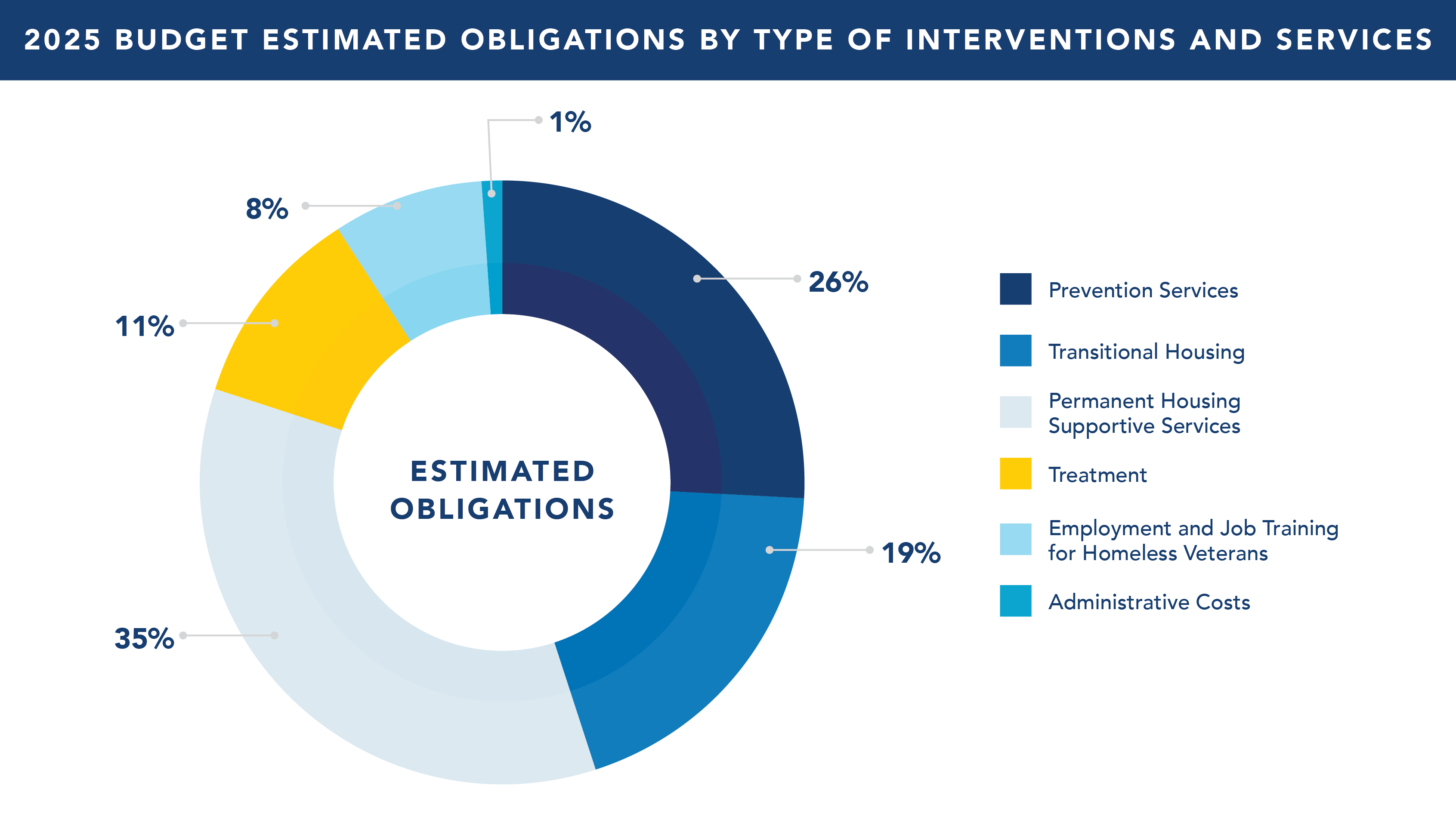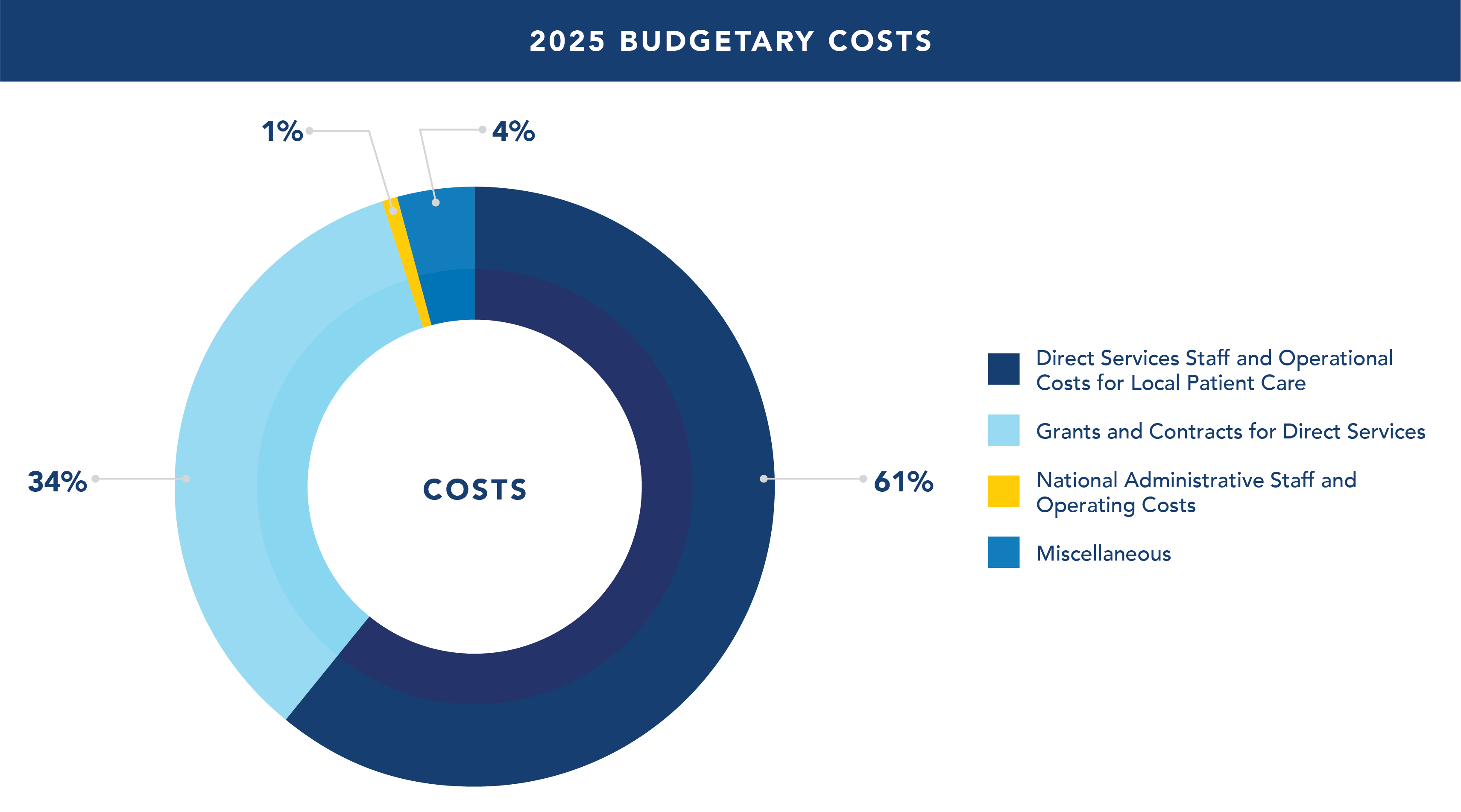Attention A T users. To access the menus on this page please perform the following steps.
1. Please switch auto forms mode to off.
2. Hit enter to expand a main menu option (Health, Benefits, etc).
3. To enter and activate the submenu links, hit the down arrow.
You will now be able to tab or arrow up or down through the submenu options to access/activate the submenu links.
Locator
Contact
Search
VA »
VA Homeless Programs
»
But Where Does the Money Go? A Closer Look at the VA Homeless Programs Fiscal Year 2025 Budget
VA Homeless Programs
But Where Does the Money Go? A Closer Look at the VA Homeless Programs Fiscal Year 2025 Budget

By Shawn Liu, Director of Communications for the VA Homeless Programs Office
Posted October 1, 2024
Have you ever wondered how much money goes toward Veteran homelessness — and what that money is used for?
The first part of that question is relatively easy to answer. For Fiscal Year (FY) 2025, VA’s budget for homeless programs is approximately $3.2 billion. That is a significant amount of money dedicated to reducing, and ultimately ending, Veteran homelessness.
The second part will take a bit more detail to explain. You may not realize it, but VA offers a wide array of services to address the full range of housing needs that Veterans may have. Let’s break this down to better understand what the budget pays for.
Breaking It Down
Our FY 2025 homeless programs budget covers 6 categories of interventions and services:
- Prevention Services
- Transitional Housing
- Permanent Housing Supportive Services
- Treatment
- Employment and Job Training for Homeless Veterans
- Administrative Costs

Prevention Services
Prevention services aim to keep Veterans from becoming homeless and often serve as the entrance into the full range of health care and benefits offered by VA. This includes:
- $659 million for the Supportive Services for Veteran Families (SSVF) program, which awards grants to nonprofit organizations and consumer cooperatives to provide both homeless prevention and rapid rehousing (i.e., permanent housing) services. That’s right — SSVF doesn’t just provide homelessness prevention, but also permanent housing services.
- $104 million for Veterans Justice Programs, which provide outreach to Veterans involved with the criminal legal system.
- $48 million for Legal Services for Veterans (LSV), which awards grants to legal aid organizations to help address legal barriers to housing stability.
- $13 million for the National Call Center for Homeless Veterans, which offers 24/7 support to homeless and at-risk Veterans who need to connect with their nearest VA.
This category totals approximately $825 million, or nearly 26% of the total budget.
Transitional Housing
Transitional housing services provide homeless Veterans with warm, safe places to stay temporarily while they search for permanent housing. This includes:
- $320 million for Grant and Per Diem (GPD), which awards grants to nonprofit organizations to provide transitional housing and supportive case management. This includes $277 million for grants and $43 million for direct service staff and operating costs.
- $283 million for Health Care for Homeless Veterans (HCHV), which awards contracts to organizations to provide emergency shelter and supportive services. HCHV also offers outreach services to help find homeless Veterans and connect them to VA, and funds coordinated entry specialist roles, which help coordinate community responses to Veteran homelessness.
This category totals approximately $603 million, or nearly 19% of the total budget.
Permanent Housing Supportive Services
Permanent Housing Supportive Services provide Veterans with access to affordable housing and intensive case management to ensure that Veterans engage with all of the resources needed to remain stably housed. This includes:
- $1.1 billion for the Housing and Urban Development-VA Supportive Housing (HUD-VASH) program.
This category totals approximately $1.1 billion, or nearly 34% of the total budget.
Treatment
Treatment represents critical health care services that help ensure housing stability. This includes:
- $259 million for Domiciliary Care for Homeless Veterans, which provides residential rehabilitative treatment specifically for homeless Veterans.
- $21 million for Homeless Patient Aligned Care Teams, which provide primary care tailored to the unique barriers that homeless Veterans face.
- $89 million for care for homeless Veterans with chronic mental health conditions.
This category totals approximately $369 million, or over 11% of the total budget.
Employment and Job Training for Homeless Veterans
Employment and job training helps Veterans obtain meaningful employment, which helps their overall financial stability. This includes:
- $232 million for Compensated Work Therapy (CWT) and CWT/Transitional Residence, which help Veterans work through the clinical aspects of job preparedness.
- $22 million for Homeless Veteran Community Employment Services, which directly help Veterans find employment.
This category totals approximately $254 million, or nearly 8% of the total budget.
Administrative Costs
Administrative costs support the work to reduce and end Veteran homelessness. This includes:
- $10 million for the National Center for Homelessness Among Veterans, which leads academic research activities to improve our scientific understanding of Veteran homelessness.
- $6 million for our National Homeless Registry, which helps us collect and analyze data on Veterans accessing VA homeless programs.
- $11 million associated with operating the Homeless Programs Office.
This category totals $21 million for research and evaluation services, and approximately $6 million towards operational administrative costs, which combined accounts for less than 1% of the total budget.
What Does This Pay For?
When it comes to what this money ultimately pays for, our FY 2025 budget can be broken down into 4 categories:
- Direct Services Staff and Operational Costs for Local Patient Care
- Grants and Contracts for Direct Services
- National Administrative Staff and Operating Costs
- Miscellaneous

Direct Services Staff and Operational Costs for Local Patient Care
This category represents the more than 6,800 social workers, peer specialists, nurses, program support assistants, and other health professionals who directly work with homeless Veterans. It also includes funding for all associated patient care-related operating costs that VA healthcare systems nationwide need to support homeless and at-risk Veterans.
This category totals approximately $2 billion, or more than 61% of the total budget.
Grants and Contracts for Direct Services
This category represents nearly 850 grants awarded to community providers — including nonprofit organizations, faith-based organizations, and consumer cooperatives — as part of the SSVF, GPD, and LSV programs. These funds are used to provide homeless prevention, rapid rehousing, transitional housing, and case management to homeless Veterans. It also represents nearly 320 contracts issued through the HCHV Contracted Residential Services programs to provide emergency shelter and supportive services.
This category totals approximately $1.1 billion, or nearly 34% of the total budget.
National Administrative Staff and Operating Costs
This category is the operating budget for the VA Homeless Programs Office, which serves as the backbone of the federal response to Veteran homelessness. This office develops policy, allocates resources, and provides guidance on implementing the budget. It also includes the funding for research, education, and evaluation of our programs and services.
This category totals approximately $41 million, or just over 1% of the total budget.
Miscellaneous
This final category includes miscellaneous costs associated with transitional housing and care for homeless Veterans with chronic mental health conditions.
This category totals approximately $114 million, or nearly 4% of the total budget.
The Impact
Our FY 2025 homeless programs budget will finance the services provided to Veterans and build upon the housing and supportive services delivered to Veterans in FY 2024, including permanently housing more than 43,000 homeless Veterans.
Our homeless programs budget was also the key driver in the 52% reduction in Veteran homelessness since 2010.
But our work is not done. Even one Veteran experiencing homelessness will always be one too many, and we won’t rest until Veteran homelessness is a thing of the past.





























